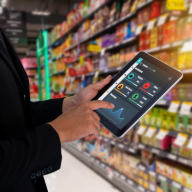New Game, New Rules

Retail
510 week ago — 8 min read
No one could have described the digital revolution better than USA-based businessman Bill Schrader. “Almost overnight, the Internet’s gone from being a technical wonder to a business must,” he said. The same applies to smartphones. With four out of five people checking their phones within 15 minutes of waking up, it’s become imperative to factor them into a business’s core strategy. Digital that mainly comprises Social, Mobile, Internet and cloud (popularly known as SMAC) is fundamentally changing the way we seek and consume information, communicate with people, transact, travel—indeed, the way we live our lives. When everything is in a flux, can businesses then afford to continue to retail in the same way they had in the past and continue to do well?
We find that retailers understand this urgent need to change their game plan, but are often held back by their lack of knowledge about what needs to be done. The recently-held Retail Technology Conclave 2015, hosted by RAI, helped throw some light on this very issue. Through thought-provoking discussions, the best brains of retail have come up with the moves retailers need to get an edge in the game.
- Mine social media for data
“The retail industry today is working on the basis of data-driven decisions,” observed Anuja Shukla, Global SI, Sales Engineering, Cloud Platform, Google. However, relying only on certain sources of data will not help derive relevance. Customers are always online and freely expressing their likes and dislikes online, which makes colossal data available. “The data available through social media cannot be ignored today. Retailers should shift from analysing transactional data to analysing social media data,” suggested Veneeth Purushotaman, CIO, Bharti Retail.
Gleaning good quality data from the deluge of data available on social media requires setting objectives. Next comes scaling up the data and using matrix models available to make sense of it. Retailers will need to engage with consumers on social media to get relevant information from them. “To not be there on social media is to not be a part of the conversation. But to not be a part of the conversation is to not be a part of the market,” warned R. Chandrashekhar, President NASSCOM.
- Convert data into action
BS Nagesh, chairman, RAI and founder, TRRAIN observed, “Everybody wants to capture insight. However, insight only happens when people on the inside utilise the data.” Sudipta Ghosh, executive director, PwC Consulting – Analytics, agreed, “Analysis is of no use without action,” Applying the insights to business helps in improving service quality and relevance to customer.
“Analytics helps in making retail better by tracking data, accumulating it, making sense of this historical data and responding in real time,” Joanne Cheigh, director, Cisco Consulting Services, Asia Pacific, Japan & China. However, the emphasis is on ‘responding’ – action. Availability of data is not going to cut it if retailers don’t convert it into action. “To be able to monetise the available data into action is what will lead to a great consumer experience,” said S. Swaminathan, CEO, Hansa Customer Equity.
- Make technology consumable
“The key is to make the available technology consumable,” advised Dulles Krishnan, executive director and Head IBM Commerce BU (Asia Pacific). This means make it easy for both external and internal customers to use it. Retailers need to conduct training programmes for the users of the technology to understand how to use it to its full potential.
“When it comes to technology, cheap and fast are the two buzz words that apply,” observed Shukla. Today, the market is replete with technology options that are inexpensive. However, it has to be simple for all to use for it actually work. As Carlton D’Silva, CEO, Hungama Digital Services said, “The best solutions/innovations are the simple ones. - Stay connected, always
“There is nothing called online or offline anymore, it’s now about whether you are connected or not connected,” said Sadashiv Nayak, CEO, Big Bazar, Food Bazar & FBB (Future Group). Internet is driving consumer behaviour. The consumers now are always online, retailers need to be online as well. That is the way to connect to consumers in the current digitised world. “It is also important to get digitised in task force management. It helps the customers stay connected and the staff happy. This is of utmost importance,” added Nayak.
Damodar Mall, CEO, Grocery Retail, Reliance Retail suggested, “Retailers should routinely arrange pop-up chat rooms and engage into horizontal sharing of information. This will help replicate good ideas and will lead to real world benefits.” It’s important to leverage all the digital tools at the disposal to stay connected because that’s where engagement will happen.
- Empower employees for improved experience
“Consumer experience comprises perception of value for money, time spent on the whole process and the satisfaction obtained after purchasing the product,” said Sanjeev Pathak, Category Head - Value Business Printing and Personal System Group, Hewlett-Packard India. It is essential to first define the target channel and then outline the experience that would cater to each channel.
“The most important commodity in providing a brilliant customer experience is a retailer’s employees,” said Pathak. The employees know the customers. Integrating the knowledge and capabilities of employees with technology helps in providing the customers with a better experience. “Customers today are well-informed about a product. The employees should be able to provide the customers with more information and knowledge regarding the same product,” suggests BS Nagesh. That will help improve the experience. - Learn from the others
“There are three kinds of organisations, first the offline whose numbers are coming down dramatically, second are the digital first companies, and lastly the initially offline and now online companies,” observed Rathin Lahiri, CMO, Meru Cabs and MeruGenie Cabs. The outcomes expected from online and offline are the same even though there is a fragmentation between the two channels. The basic idea is to connect the shoppers and the businesses together. Companies that are predominately on one specific channel have perfected their processes on that channel.
To be able to truly satisfy the customer, retailers on other channels need to learn from them—be it product assortment, capturing data, converting insights or response time. Keep an eye open for practices that are smart and bring about an improvement in any area of the business, and adopt them. Companies that continue to learn, continue to grow. - Don’t stop innovating
Innovation can even mean finding a unique way of applying technology. Finding new ways of using the digital tools available is important in attracting and keeping consumer attention. As international marketing guru David Meerman Scott has said, “You can buy attention (advertising). You can beg for attention from the media (PR). You can bug people one at a time to get attention (sales). Or you can earn attention by creating something interesting and valuable and then publishing it online for free.”
Now that you know the new rules of the game, it will serve you to heed to advice by the genius Albert Einstein, “You have to learn the rules of the game. And then you have to play better than anyone else.”
Image and Article Source: STOrai Magazine
View STOrai 's profile
Other articles written by STOrai Magazine
The Art & Science of People Pleasing in Retail
21 week ago
Most read this week













Comments
Share this content
Please login or Register to join the discussion